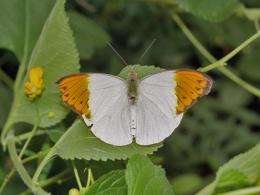Hebomoia glaucippe. Credit: Wikipedia
(Phys.org)—A team of Austrian researchers has found that Hebomoia glaucippe, known as the great orange tip butterfly, has a toxin in its wing tips that is identical to a toxin used by a predatory sea snail to kill prey. They write in their paper describing their finding, published in the Proceedings of the National Academy of Sciences, that it appears the toxin in butterfly wings is used as a means of defense rather than as a weapon.
The great orange tip butterfly belongs to the Pieridae family of White and Yellow butterflies and inhabits temperate Asian climates such as those found in the island nations of the Philippines, Indonesia and Malaysia. They are all white save for the upper half of their upper wings which are bright orange. They are the largest of the lepidopteran family.
In studying H. glaucippe the research team homogenized the wings and bodies of sample specimens allowing them to extract proteins found in them. In so doing, they discovered the presence of one, glacontryphan-M, a peptide toxin that had previously only been found in a species of sea snail: Conus marmoreus, more commonly known as the marble cone snail.
C. marmoreus injects toxic chemicals into its prey via a harpoon, paralyzing it, which allows for easy consumption. One of the toxic chemicals it uses is the same peptide the research team has found in the wingtips of H. glaucippe, leading to questions regarding the lineage of both species and if they perhaps evolved from a shared distant relative.
Great orange tip butterflies don't attack prey, thus the toxin in their wings is assumed to be a defensive mechanism designed to ward off a wide variety of predators that include: spiders, ants, mantes, green frogs, lizards, and birds. The researchers note that the presence of the toxin in the wings doesn't always work as planned however, as many of its predators eat the body and ignore the wings and some, such as geckos appear to be impervious to it effects altogether.
To answer questions about why the butterfly and snail share a toxin, the researchers plan to obtain more great orange tip samples from other environments and to test other species to see if they too share the toxin.
More information: Peptide toxin glacontryphan-M is present in the wings of the butterfly Hebomoia glaucippe (Linnaeus, 1758) (Lepidoptera: Pieridae), PNAS, Published online before print October 15, 2012, doi: 10.1073/pnas.1209632109
Abstract
Protein profiling has revealed the presence of glacontryphan-M, a peptide toxin identified only in the sea snail genus Conus, in the wings of Hebomoia glaucippe (HG). The wings and body of HG were homogenized and the proteins were extracted and analyzed by 2D gel electrophoresis with subsequent in-gel digestion. Posttranslational protein modifications were detected and analyzed by nano–LC-MS/MS. An antibody was generated against glacontryphan-M, and protein extracts from the wings of HG samples from Malaysia, Indonesia, and the Philippines were tested by immunoblotting. Glacontryphan-M was unambiguously identified in the wings of HG containing the following posttranslational protein modifications: monoglutamylation at E55, methylation at E53, quinone modification at W61, cyanylation at C56, and amidation of the C terminus at G63. Immunoblotting revealed the presence of the toxin in the wings of HG from all origins, showing a single band for glacontryphan-M in HG samples from Malaysia and Philippines and a double band in HG samples from Indonesia. Intriguingly, sequence analysis indicated that the Conus glacontryphan is identical to that of HG. The toxin may function as a defense against diverse predators, including ants, mantes, spiders, lizards, green frogs, and birds.
Journal information: Proceedings of the National Academy of Sciences
© 2012 Phys.org





















